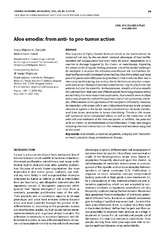Приказ основних података о документу
Aloe emodin: from anti- to pro-tumor action
| dc.creator | Mijatović, Sanja | |
| dc.creator | Maksimović-Ivanić, Danijela | |
| dc.date.accessioned | 2019-04-09T10:47:59Z | |
| dc.date.available | 2019-04-09T10:47:59Z | |
| dc.date.issued | 2018 | |
| dc.identifier.uri | http://hrana-ishrana.org/wp-content/uploads/2019/01/Hrana-i-ishrana-59-br-2.pdf | |
| dc.identifier.uri | https://radar.ibiss.bg.ac.rs/handle/123456789/3319 | |
| dc.description.abstract | Poor response of highly invasive forms of cancer to the treatment can be explained not only by the cell death resistant phenotype of low/undiff erentiated cell subpopulation but even more, by tumor repopulation as a reaction to damage triggered by the chemo- or radiotherapy. Regarding the serious limits of regular healing protocols, one of the pivotal challenges for biologists is to prove the relevance and discover the mechanisms behind traditional medicine-based tumor healing. One of the oldest and most powerful plants with 4000 years long tradition in folk medicine, Aloe vera is intensively studied during last century due to the treasure of active compounds with proven biological potential attractive not only for physicians and patients but also for scientists. Anthraquinones, emodin and aloe emodin (AE), derived from Aloe vera and diff erent plants from Polygonaceae family are defi nitely the most researched constituents. Aloe emodin owns multiple anti-tumor properties realized through induction of cell cycle arrest, cell death, diff erentiation and suppression of the malignant cell motility. However, its interaction with tumor cells is not unidirectional and due to the complex network of signals in the tumor microenvironment can be easily transformed from tumor destructive to tumor-stimulating. Therefore, this review will summarize direct tumoricidal eff ects as well as the interaction of AE with cells and mediators of the immune system. In addition, the potential of AE as chemo- or photosensitizer will be elaborated. Finally, new designs including chemical interventions on this molecule and nanotechnology will be discussed. | en |
| dc.relation | info:eu-repo/grantAgreement/MESTD/Basic Research (BR or ON)/173013/RS// | |
| dc.rights | openAccess | |
| dc.source | Hrana i Ishrana | |
| dc.subject | Aloe emodin | |
| dc.subject | Anticancer properties | |
| dc.subject | Interplay with microenvironment | |
| dc.subject | Cytostatic drugs | |
| dc.subject | Photodynamic therapy | |
| dc.title | Aloe emodin: from anti- to pro-tumor action | en |
| dc.type | article | en |
| dc.rights.license | ARR | |
| dcterms.abstract | Максимовић-Иванић, Данијела; Мијатовић, Сања; Aлое емодин: фром анти- то про-тумор ацтион; | |
| dc.rights.holder | © 2018 Društvo za ishranu Srbije | |
| dc.citation.issue | 2 | |
| dc.citation.volume | 59 | |
| dc.citation.apa | Mijatović, S., & Maksimović-Ivanić, D. (2018). Aloe emodin: from anti- to pro-tumor action. Hrana i Ishrana, 59(2), 59–67. | |
| dc.citation.vancouver | Mijatović S, Maksimović-Ivanić D. Aloe emodin: from anti- to pro-tumor action. Hrana i Ishr. 2018;59(2):59–67. | |
| dc.citation.spage | 59 | |
| dc.citation.epage | 67 | |
| dc.type.version | publishedVersion | en |
| dc.identifier.fulltext | https://radar.ibiss.bg.ac.rs//bitstream/id/4940/HranaiIshrana_2018_59_2_59-67.pdf | |
| dc.citation.rank | M52 | |
| dc.identifier.rcub | https://hdl.handle.net/21.15107/rcub_ibiss_3319 |

